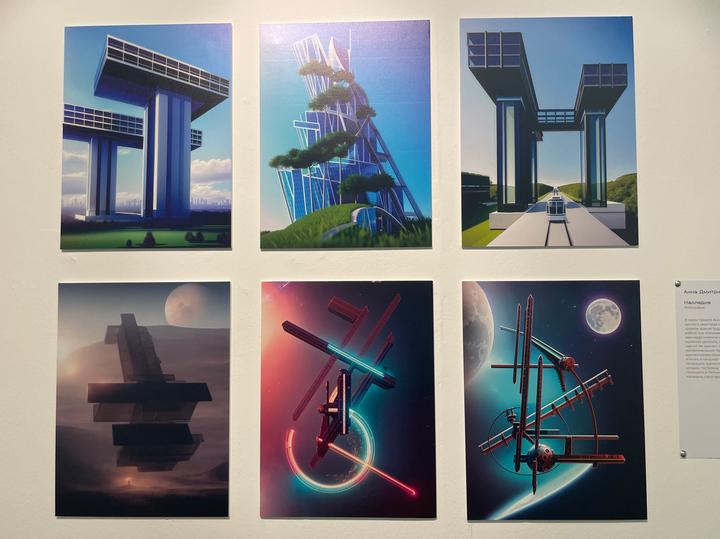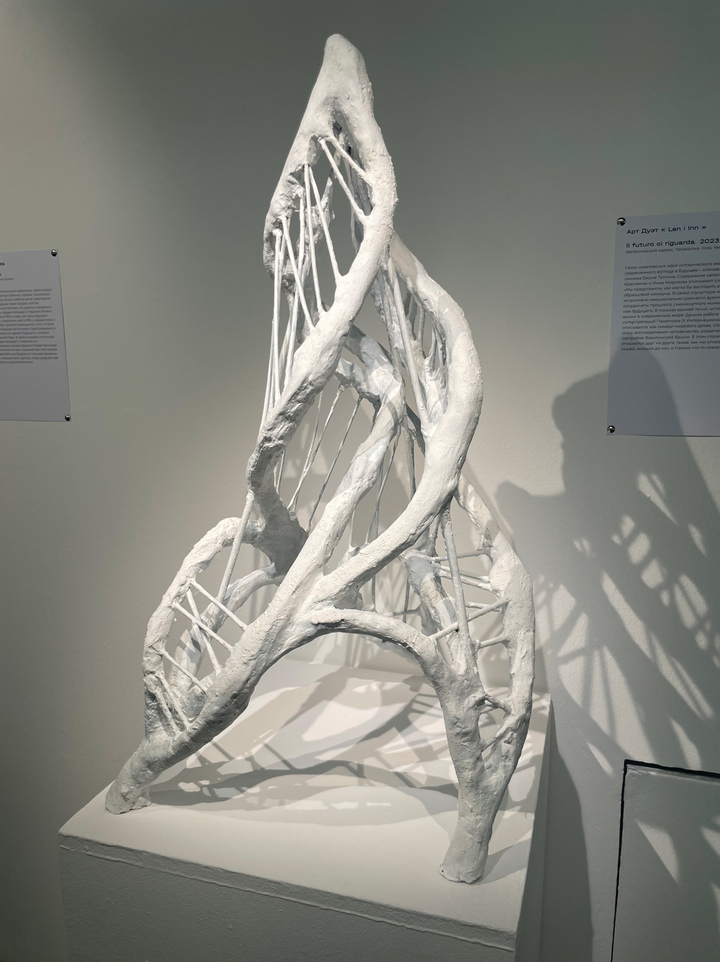Aliens planted potatoes in the Russian outback
[ad_1]
The exhibition “Common Future” showed scenarios for the future
What will happen if aliens land in the Russian outback? But what if a person comes up with a way to become immortal? Or learn to build cities in space – what will they be like? At the exhibition “Common Future” in the Gallery on Shabolovka, young artists presented scenarios for the future. The project was a continuation of the exhibition “At the Gates of the Commune” – the first vernissage at the exhibition site, with which it reopened after a six-month break in work. That study was based on utopian ideas that arose at the dawn of the Soviet state – a hundred years ago. However, in the futuristic continuation, one can hear not only echoes of the distant past, but also of today’s present.
The exhibition begins with a collective portrait, of which the viewer can become a part. Before us is a diptych “East-West” by Katerina Sereznaya – photo printing on a mirror. At one job, dozens of people in identical costumes turn into pixels, among which there are mirror “gaps”. In the neighboring collage, these pixels already resemble grass growing among mirrored birches, along which a lone figure wanders, almost dissolving in the collective space. Thus, the author reflects on cyclicality, where “the Western individualistic model is replaced by the Eastern collectivist one.” Perhaps now such a turn is taking place? What can it lead to?
This is what the main exposition, conceived and logically built by the curator Alexander Kremer, is about. It opens with a largely comic video work “Arrival” by the group “Sodruzhestvo”, created in the genre of documentary science fiction. The plot is as follows: aliens arrive on Earth and find themselves in a remote village. The locals welcome them kindly. The old woman teaches her how to plant potatoes in the garden and, along the way, talks about her problems: about a small pension, ten great-grandchildren, and a neighbor who stole cans. Life outside the Earth is of little concern to my grandmother: “We don’t need any Internet, God bless you.” Contact with local male tractor drivers develops in much the same way – they are not afraid of strange luminous creatures and tell them about the breakdowns of their machines. Representatives of an extraterrestrial civilization soon master the shovel and dissolve into a leisurely village life, which seems to be no different from today.
The next fantasy represents a future where a bioengineering company has learned how to create artificial living organisms that help to become superhuman. It is worth attaching a creature resembling a mollusk to your body, as memory and health improve, a person becomes immortal. All this leads to a “living revolution” that radically changes people’s lives. But along with the pluses, there are problems that, again, are largely consonant with modern ones. There are those who believe that it is impossible to live at the expense of another living being, others do not have enough money to buy an amphibian – these people become outcasts. They are not hired, and the children are assigned to separate schools – for the “unfavorable”. Someone’s phobias are exacerbated – despite the fact that people stop getting sick, grow old and die, a fear of death suddenly appears, which leads to the fact that a person stops leaving the house. All these nuances of immortality are told through the stories of specific people that we see in the photographs (with amphibians on the body) and read their personal stories under the pictures.

A series of works at the exhibition is devoted to Soviet projects that could be implemented in the future. So, Anna Dmitri, using neural networks, represents the objects of Lissitzky and Tatlin, Chernikhov and Malevich in the form of space stations operating in orbits of different planets. Actually, many of them were a dream of a space future, and became prototypes of real aircraft, so it is reasonable to visualize intergalactic cities in this way. A similar idea belongs to Elena Sharganova, who draws (already without neural networks) a metropolis of the future based on the project of Chernikhov and Corbusier, but connects it with an archival map of her native Nelidovo, a small mining town in the Tver region. The art duo “Len I inn” are reworking Tatlin’s “Monument to the Third International” in a new version, creating a “tower of an exemplary commune”. In the layout of the monument, his avant-garde “skeleton” is read, but it seems to be overgrown with skin, turning into an almost living being.

The final point is an audio-visual installation by Anna Kirillina – in the form of a soft purple booth with spikes. You need to go inside to hear many voices that combine into a strange melody, where there are meditative and painful notes. With this common and at the same time disparate rumble, the artist says that a bright future requires not only the development of technologies, but also the search for new values and meanings. We will continue to step on the same rake if we do not go through spiritual evolution, which should be based on respect for traditions and the ability to accept diversity.
[ad_2]
Source link






